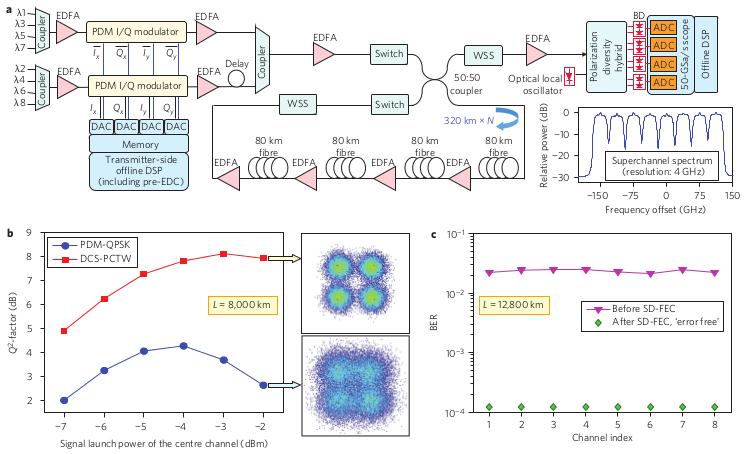The new noise reduction technology allows you to transfer 400 Gb / s over fiber for 12 800 km without signal repeaters
Scientists from Bell labs have developed and tested a new way to combat noise and distortion in the transmission of an optical signal. They demonstrated an effective data transfer rate of 400 Gb / s over a distance of 12,800 kilometers. The principle of operation of the noise reduction system resembles a balanced (symmetric) connection that has long been used in audio technology - the signal is divided into two parts, one of them is transmitted as usual, and the second in antiphase. On the receiving side, the second part flips again and folds with the first. As a result, the distortions and interference that fell into both signals are mutually destroyed, and the signal itself is amplified by 6 dB:

Everything happens in the optical fiber in approximately the same way, only the main wave and its “twin” in antiphase are transmitted in mutually perpendicular planes of polarization. Due to this, the level of nonlinear distortion was reduced by 8.5 dB. In the course of the main experiment, using wavelength division multiplexing, they achieved a “raw” bitrate of 512 Gb / s, which, after subtracting the overhead for error correction codes, yielded 406.6 Gb / s. The signal was transmitted through a cable consisting of 160 segments of 80 kilometers, between which there were only EDFA optical amplifiers .

a. The scheme of the experimental setup. b. Comparison of signal quality using the new noise reduction scheme and without it. from.The number of errors in the signal that has passed 12800 km before and after error correction.
The technology, called PCTW ( Phase-Conjugated Twin Waves ), will reduce the number of repeaters over long distances or even completely abandon them, leaving only amplifiers. This can significantly reduce the cost of laying transcontinental fiber optic communication lines. At short distances, it is possible to reduce the overhead of error correction codes and increase the bandwidth.

Everything happens in the optical fiber in approximately the same way, only the main wave and its “twin” in antiphase are transmitted in mutually perpendicular planes of polarization. Due to this, the level of nonlinear distortion was reduced by 8.5 dB. In the course of the main experiment, using wavelength division multiplexing, they achieved a “raw” bitrate of 512 Gb / s, which, after subtracting the overhead for error correction codes, yielded 406.6 Gb / s. The signal was transmitted through a cable consisting of 160 segments of 80 kilometers, between which there were only EDFA optical amplifiers .

a. The scheme of the experimental setup. b. Comparison of signal quality using the new noise reduction scheme and without it. from.The number of errors in the signal that has passed 12800 km before and after error correction.
The technology, called PCTW ( Phase-Conjugated Twin Waves ), will reduce the number of repeaters over long distances or even completely abandon them, leaving only amplifiers. This can significantly reduce the cost of laying transcontinental fiber optic communication lines. At short distances, it is possible to reduce the overhead of error correction codes and increase the bandwidth.
